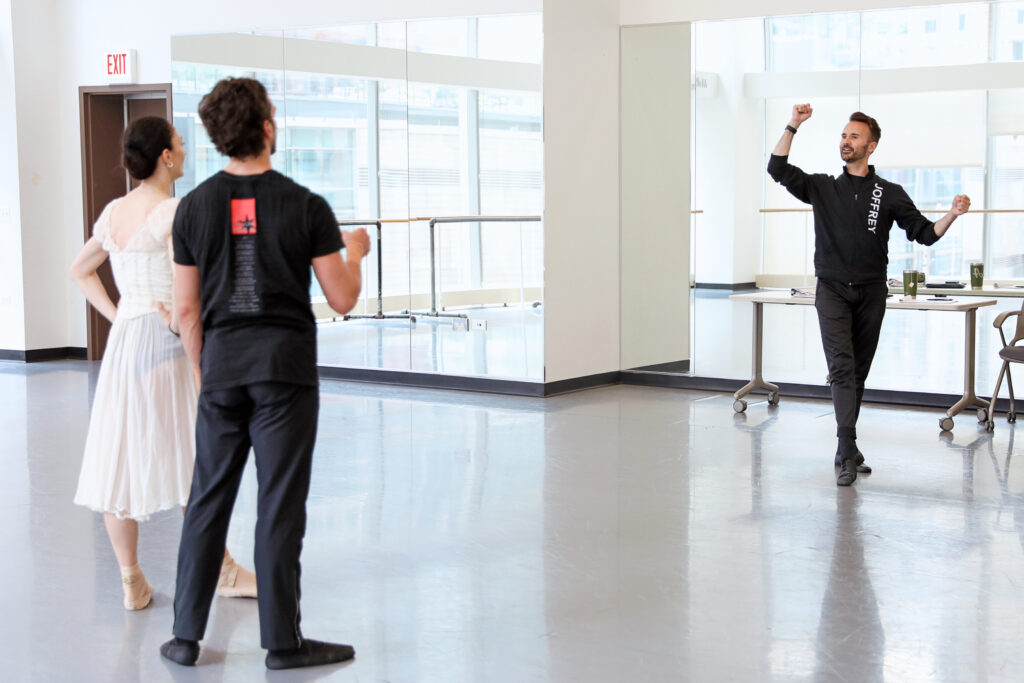A (Very Busy) Day in the Life of a Rehearsal Director
It shouldn’t come as a surprise that Adam Blyde enjoys starting his day with crossword puzzles—his natural affinity for problem solving suits his many duties as a rehearsal director for The Joffrey Ballet. “We teach class, we’re in the studio with the dancers for all of their working hours—that’s kind of the obvious aspect of what we do,” Blyde says. “Then there’s a lot of behind-the-scenes things, like the schedule, casting logistics, meeting the needs of the marketing or development departments, and making sure the dancers are available, production meetings… We do a bit of everything!”

Prior to stepping into his role as rehearsal director in 2016, Blyde, a Royal Ballet School–trained London native, danced with the Scottish Ballet and Rambert Dance Company. “I was freelance-teaching for a bit before I heard about this position at Joffrey,” he says. Artistic director Ashley Wheater invited him to set Jiří Kylián’s Forgotten Land on the company to see if he would be a good fit. “Even when I was still dancing, [being a rehearsal director] was something I was always interested in,” says Blyde. “I enjoy the craft of the studio work and the logistics, whether it’s creating a new ballet or putting together “Waltz of the Flowers.’ ”
Below, Blyde takes us through his typical (and very busy) day.
7 am: Wake up. “I’m a coffee and crosswords person in the morning—it gets my brain going.” Once he’s ready for the day, Blyde’s commute includes a mile walk and then taking the “L,” Chicago’s public-transit train.
8:30 am: Arrive at the Joffrey studios. “I’m in my office preparing—going over notes, reviewing videos, talking to the choreographer,” says Blyde. “It really depends on the day.”
9:45 am: Company class. “We alternate who’s teaching every day, so if I’m not teaching, most of the time I’m in meetings or continuing to prepare for rehearsals,” Blyde says. “This is also when we see if any dancers are sick and adjust the schedule.”
11:30 am–2:30 pm: Rehearsal. “I could either be teaching repertoire, assisting a choreographer with their creation, or coaching dancers in group, solo, or pas de deux,” Blyde says. “There is something special about setting a piece and then working on it and seeing the dancers’ development—whether it be a group or solo work. Watching people grow and seeing their artistic journey develop is really fulfilling.”

2:30 pm: Lunch break. “It’s technically lunch, but normally for me it’s just a salad at my desk while we continue with meetings or do paperwork.”
3:30 pm–6:30 pm: Rehearsals continue. “[They] vary from program to program,” Blyde says. “Sometimes in the afternoon, like for Nutcracker, for example, this is when we will rehearse with the children. Otherwise, it’s similar to the morning.”
6:30 pm: Rehearsals end. Blyde goes back to his office to respond to emails and finalize what needs to be done in the following days.
7:30 pm: “I usually don’t leave work until around 7:30—it’s quite a long day, actually. I think some of the dancers underestimate how long our day is,” Blyde says.
8 pm: Return home. “I usually have dinner made for me when I get home. My partner, Rodrigo, is an amazing cook,” Blyde says. After dinner, he prepares for the next day, watching video and reviewing notes. “We sometimes will watch an episode of a TV show, but usually there’s a lot to be done, so it’s never just three hours of television.”
11 pm: Bedtime. “Before bed I like to read a bit—I read almost exclusively fiction. Or sometimes I do crossword puzzles again just to help me wind down.”

Performance days: When the company performs, “everything gets pushed further back in the day,” says Blyde. For artistic staff, that means more time in the morning for meetings and paperwork. “It’s a good time to figure out the logistics of casting for the next show.”
Class usually starts at 12:15, followed by two hours of rehearsal. “Then usually I like to get a bite to eat before I come back to teach warm-up,” Blyde says. Like company class, the rehearsal directors rotate teaching the optional 45-minute warm-up class before the performance. Blyde will then head into the audience to watch the show. Afterwards, he’ll join artistic staff backstage to thank the dancers. “We don’t give dance notes after a show,” he says. “It just doesn’t feel right when everyone is on their post-performance high. But we will talk about production elements, like light cues, with the production team before heading home.”
Days off: “As rehearsal directors we try to stick with [the dancers’] schedule of days off so we can also have a break,” Blyde says. “But generally we are all still on email. There’s not much that gets left to the next day, which I think is just part of our personality—you have to be a little type A.”
Blyde follows a similar morning routine of coffee and crosswords. Other than going to a yoga class, he and his partner prefer to have a fairly quiet day at home, although he does enjoy going out to eat. Days off are also a good time for Blyde to FaceTime with his family in London.






